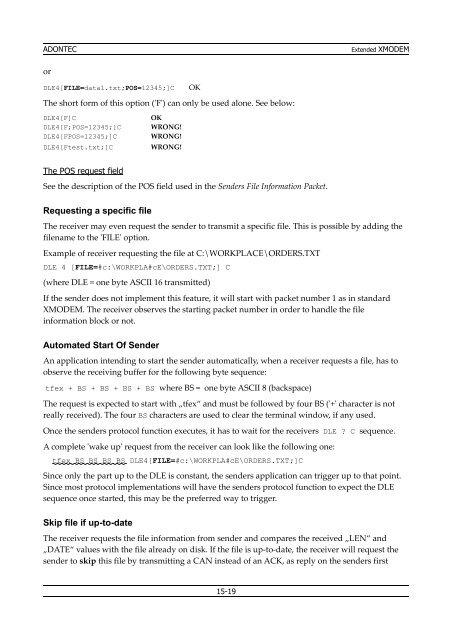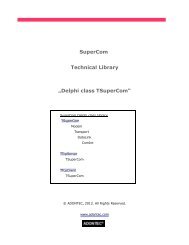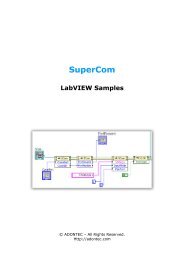The Extended XMODEM protocol - Adontec
The Extended XMODEM protocol - Adontec
The Extended XMODEM protocol - Adontec
You also want an ePaper? Increase the reach of your titles
YUMPU automatically turns print PDFs into web optimized ePapers that Google loves.
ADONTEC <strong>Extended</strong> <strong>XMODEM</strong><br />
or<br />
DLE4[FILE=data1.txt;POS=12345;]C OK<br />
<strong>The</strong> short form of this option ('F') can only be used alone. See below:<br />
DLE4[F]C OK<br />
DLE4[F;POS=12345;]C WRONG!<br />
DLE4[FPOS=12345;]C WRONG!<br />
DLE4[Ftest.txt;]C WRONG!<br />
<strong>The</strong> POS request field<br />
See the description of the POS field used in the Senders File Information Packet.<br />
Requesting a specific file<br />
<strong>The</strong> receiver may even request the sender to transmit a specific file. This is possible by adding the<br />
filename to the 'FILE' option.<br />
Example of receiver requesting the file at C:\WORKPLACE\ORDERS.TXT<br />
DLE 4 [FILE=#c:\WORKPLA#cE\ORDERS.TXT;] C<br />
(where DLE = one byte ASCII 16 transmitted)<br />
If the sender does not implement this feature, it will start with packet number 1 as in standard<br />
<strong>XMODEM</strong>. <strong>The</strong> receiver observes the starting packet number in order to handle the file<br />
information block or not.<br />
Automated Start Of Sender<br />
An application intending to start the sender automatically, when a receiver requests a file, has to<br />
observe the receiving buffer for the following byte sequence:<br />
tfex + BS + BS + BS + BS where BS = one byte ASCII 8 (backspace)<br />
<strong>The</strong> request is expected to start with „tfex“ and must be followed by four BS ('+' character is not<br />
really received). <strong>The</strong> four BS characters are used to clear the terminal window, if any used.<br />
Once the senders <strong>protocol</strong> function executes, it has to wait for the receivers DLE ? C sequence.<br />
A complete 'wake up' request from the receiver can look like the following one:<br />
tfex BS BS BS BS DLE4[FILE=#c:\WORKPLA#cE\ORDERS.TXT;]C<br />
Since only the part up to the DLE is constant, the senders application can trigger up to that point.<br />
Since most <strong>protocol</strong> implementations will have the senders <strong>protocol</strong> function to expect the DLE<br />
sequence once started, this may be the preferred way to trigger.<br />
Skip file if up-to-date<br />
<strong>The</strong> receiver requests the file information from sender and compares the received „LEN“ and<br />
„DATE“ values with the file already on disk. If the file is up-to-date, the receiver will request the<br />
sender to skip this file by transmitting a CAN instead of an ACK, as reply on the senders first<br />
15-19





